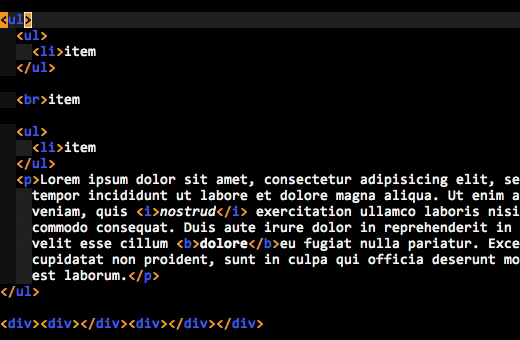A Vim Plugin That Always Highlights the Enclosing Tags
Posted on September 12, 2012
Just recently I started editing HTML much more than I usually do1 and I noticed Vim was missing an awesome feature Notepad++ had. The last time I used Notepad++ was many years ago, but I still remember it used to highlight the other tag in the pair when your cursor was inside one of them.
[For those who want to skip to the end, the plugin I built is called MatchTagAlways.]
Sure enough, I wasn’t the only one who noticed that Vim was missing this awesome feature. A kind soul even took it upon himself to implement said missing functionality as a Vim plugin that does exactly what it says on the tin, and does it well.
But you know what? I want more than that.
I don’t want Vim to “just” highlight the other tag in the pair when my cursor is inside the tag, I want it to always highlight the tags that enclose the cursor. I’ve seen Sublime Text 2 trying to point out the enclosing tags with a dotted line, but I’ve also seen it fail in the face of unclosed tags common in HTML5 syntax.2
Here’s an animated GIF of what I’m talking about:

Do you see how the enclosing tags are always highlighted, even when you are inside the element’s content? That’s what I wanted.
So I wrote a plugin that does it. The GIF you just saw is MatchTagAlways in action. It’s plug & play, comes with sane defaults and should require no configuration (although there are knobs to tweak if you want to do that).
Implementing this is actually surprisingly tricky to get right if you want to support use-cases like templating languages and the aforementioned HTML5 syntax. There’s a ridiculous number of corner cases to handle, and MTA implements far too much of an HTML parser for my liking.3
Anyway, use it if you edit HTML or XML if this looks like a feature you’d like to have. Note that your copy of Vim needs to come with Python support. More details can be found in the plugin’s docs.
-
I write it in bursts, but day-to-day I mostly write C++ or Python. ↩
-
Quite a bit of it with regular expressions. Yes, I know, I’m going to hell. But it still works in 99.99% of the use-cases and fuck me if I’m going to write an actual HTML parser that works from the “inside out”4 just for this, because that’s what I need and it doesn’t exist. ↩
-
By “inside out” I mean it starts from a specific line and column number and parses up and down. No, you can’t use a “normal” parser. MTA only looks at the HTML code that is on the screen for the sake of performance and that won’t parse sensibly with a normal parser, especially when you throw in the “has to work with templates” requirement. No, not even Beautiful Soup. Yes, I’ve tried. The current solution is pretty damn robust. ↩